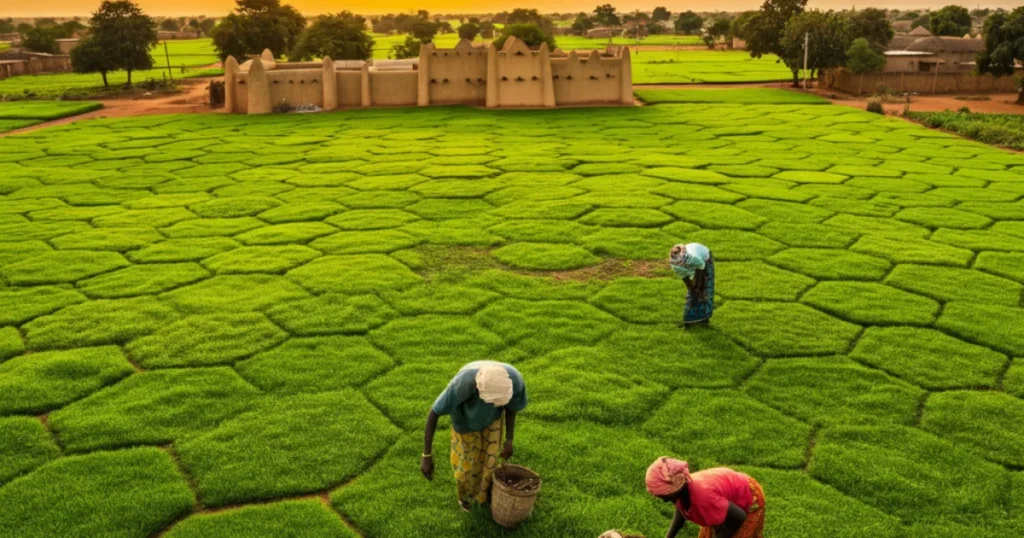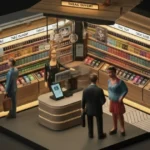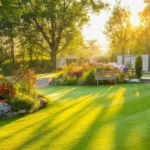Burkina Faso, a landlocked country in West Africa, is well-known for its diverse landscapes, thriving agricultural industry, and deep cultural heritage. Among its lesser-known treasures is its high-quality turf industry. From decorative lawns to practical applications in sports, Burkina Faso turf has emerged as an important resource for both local communities and broader markets. But what makes this industry so unique? How has it played a role in the region’s culture, economy, and sustainability? This blog explores the history, significance, and future prospects of Burkina Faso turf, offering insights into its evolving place on the global stage.
History and Significance
Turf in Burkina Faso is more than greenery; it’s intertwined with the region’s history and traditions. For centuries, the people of Burkina Faso have utilized turf not only for its aesthetic value but also for its practical benefits, including its ability to reduce dust and conserve water in rural areas. Public spaces such as parks and community gathering areas in cities like Ouagadougou often proudly display well-maintained turf as a symbol of cohesion and progress.
Additionally, turf has cultural significance in sports. Football (soccer) is a national passion in Burkina Faso, with the maintained turf playing fields serving as a vital component of community life. It’s common for villages and neighborhoods to rally around these spaces for tournaments and events, with turf fields considered a point of pride.
Types of Turf
The types of turf cultivated in Burkina Faso vary based on climate suitability and end purpose. The following are the most commonly found varieties:
1. Natural Turf
Natural turf accounts for a large portion of Burkina Faso’s local turf use. These grasses are typically hardy and drought-resistant, making them ideal for the country’s semi-arid conditions. Common types include Bermuda grass (a favorite for sports fields and lawns) and Zoysia grass, prized for its low-maintenance qualities.
2. Artificial Turf
Urbanization and the rising demand for sports facilities have spurred the growth of artificial turf in Burkina Faso. Synthetic options are increasingly used in football stadiums and commercial spaces. They provide a low-maintenance, long-lasting alternative to natural grass, especially in areas where water availability is limited.
3. Hybrid Grass
Hybrid turf, a mix of natural grass reinforced with synthetic materials, is slowly gaining attention in Burkina Faso, especially in professional sports arenas. This variety combines the lush look of natural grass with the durability and resilience of artificial turf.
Cultivation and Maintenance
Growing natural turf in Burkina Faso demands careful attention, particularly given the country’s hot climate and uneven rainfall patterns. Here are the best practices for cultivation and upkeep:
- Preparation: Soil preparation is vital. The naturally dry soils in Burkina Faso require amending with organic materials to improve water retention and nutrient content.
- Irrigation: Proper irrigation is key to ensuring healthy turf growth in the arid climate. Additionally, local farmers often use drip irrigation methods to minimize water consumption.
- Mowing and Trimming: Proper mowing practices are followed depending on the grass type. Cutting only one-third of the top layer helps maintain turf health.
- Fertilization: Bio-friendly fertilizers are recommended to promote growth while minimizing environmental impact.
- Pest Management: Integrated pest management (IPM) techniques are deployed to control turf-damaging pests without relying heavily on chemical pesticides.
For artificial and hybrid turf, maintenance focuses on cleaning, repairing tears, and ensuring even playing surfaces.
Economic Impact
The turf industry plays a surprising yet significant role in Burkina Faso’s economy. It supports several sectors, from agriculture and landscaping to sports infrastructure. Small-scale farmers have particularly benefited, as cultivating turf gives them an additional cash crop with relatively low water dependency.
Sports events and recreational areas utilizing turf bring both direct and indirect economic gains. Football tournaments, for example, generate revenue for local businesses, including food vendors, transportation providers, and sports retailers. Additionally, the production of artificial turf has led to increased partnerships with international companies that supply materials or technology, further integrating Burkina Faso into global business networks.
Challenges and Solutions
Regardless of its benefits, the turf industry in Burkina Faso faces distinct challenges. Environmental concerns top the list, especially the excessive water usage involved in growing natural turf and waste from synthetic varieties. Additionally, land-use conflicts can arise when agricultural terrain is converted for turf cultivation.
Solutions and Best Practices
Several solutions have been proposed and, in some cases, implemented to address these challenges:
- Drought-Resistant Varieties: Developing and promoting grasses that require less water would significantly reduce the environmental toll of natural turf farming in this dry region.
- Recycling Artificial Turf: Collaborations with international partners are helping Burkina Faso adopt sustainable practices for recycling and repurposing synthetic turf materials.
- Land Management Policies: Local governments are working on regulations to ensure agricultural land use remains balanced and sustainable.
Education and outreach programs can also increase farmer and community awareness on sustainable turf management practices.
Future Trends
The future of Burkina Faso turf holds promise as innovation and sustainability initiatives gain momentum. Researchers are working to enhance the climate resilience of natural turf, developing types tolerant to heat and low water conditions. Meanwhile, technological advancements in artificial turf are making it more eco-friendly, incorporating recyclable materials and better drainage systems that reduce water runoff.
Another exciting trend is vertical gardening and turf. This approach enables urban areas to incorporate green walls and vertical turf plots, maximizing greenery in limited spaces, reducing heat, and improving air quality.
Digital tools and mobile apps are also gaining traction, offering turf growers real-time data and recommendations to improve their cultivation processes, benefiting both large-scale producers and small-scale farmers.
Where Burkina Faso Turf Stands Today
Burkina Faso’s focus on turf encapsulates much more than just greenery. It is a testament to the country’s efforts to balance cultural identity, economic growth, and environmental sustainability. Through innovative approaches, effective land management, and an eye on global best practices, Burkina Faso is poised to strengthen its standing as a regional leader in turf cultivation and usage.
If you’re inspired by how Burkina Faso is transforming turf into an economic and cultural asset, consider staying updated on further innovations in this space. Together, we can support growth and sustainability, paving the way for greener, more efficient futures.





